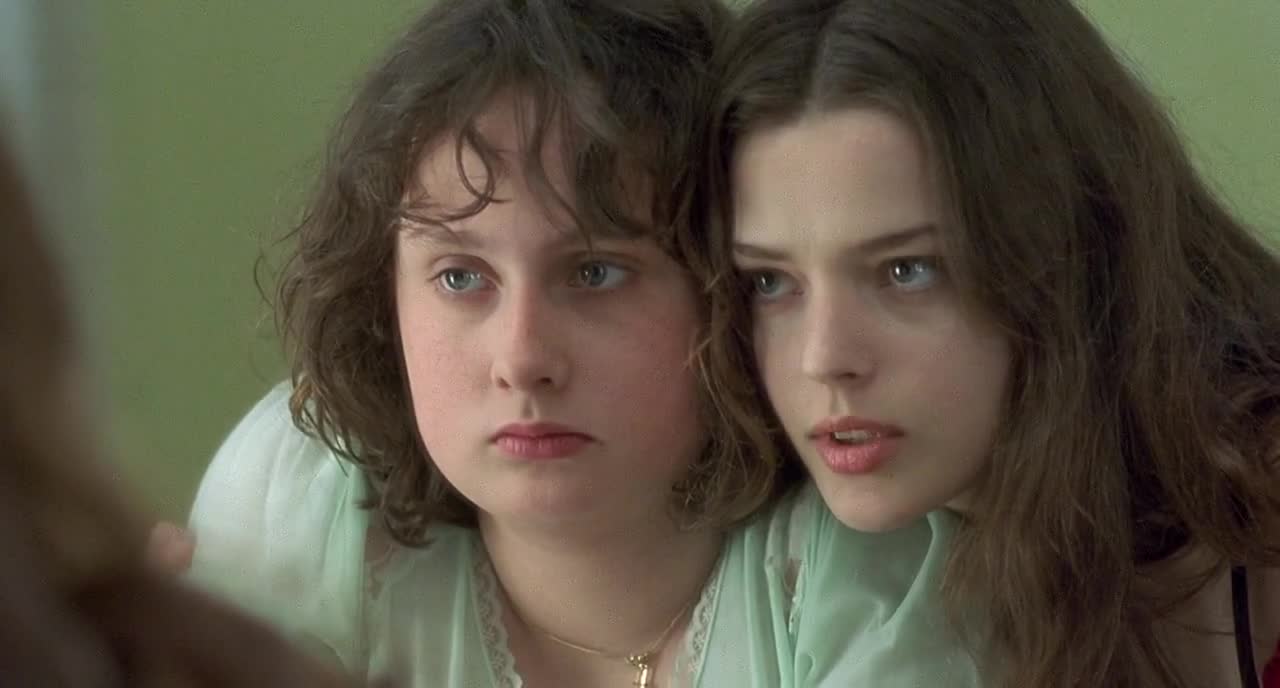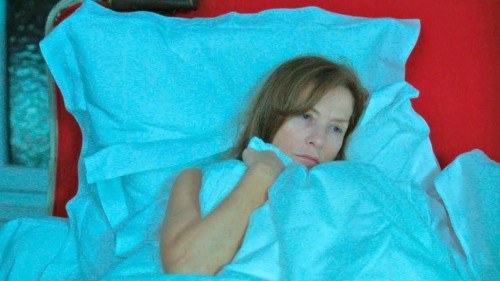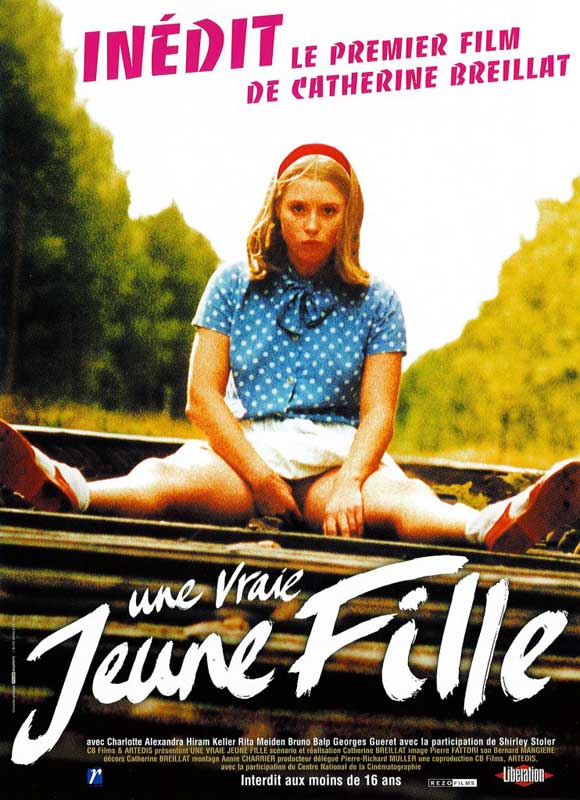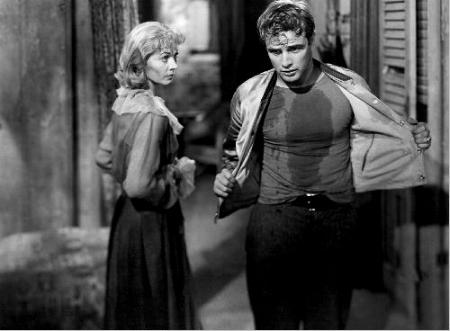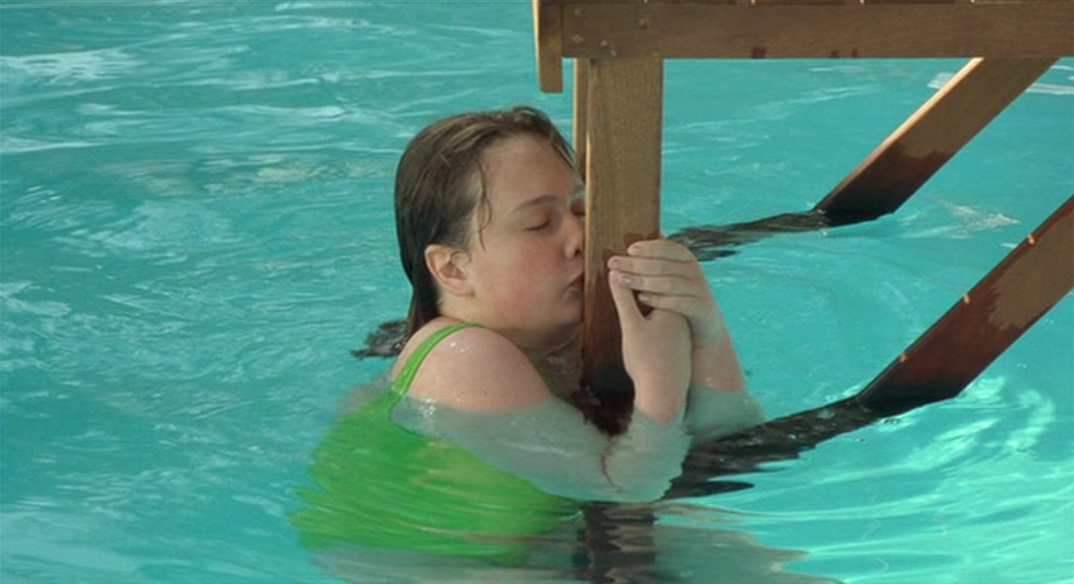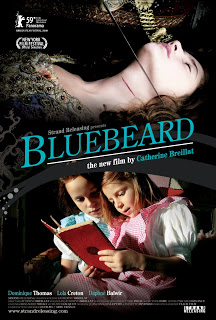This guest post written by Tessa Racked originally appeared at Consistent Panda Bear Shape and appears here as part of our theme week on Sisterhood. It is cross-posted with permission.
[Trigger warning: discussion of rape]
Fat Girl is a coming-of-age story about two sisters on summer vacation with their family: chubby 13-year-old Anaïs (Anaïs Reboux) and slender 15-year-old Elena (Roxane Mesquida). A scene in the middle of the film serves as a cypher for the central paradox of the sisters’ relationship. Elena and Anaïs stand cheek to cheek, regarding themselves in the mirror. “It’s funny. We really have nothing in common,” Elena says. “Look at you. You have small, hard eyes, while mine are hazy. But when I look deep into your eyes, it makes me feel like I belong, as if they were my eyes.” The core of Fat Girl is these two girls, who contrast each other in some very essential ways, but are inexorably bound together by shared experiences. Both are adolescents grappling with the early throes of sexuality, but their divergent appearances and ages leave them in different positions socially, affecting their worldviews. Their different experiences come up in the first conversation we hear between them: Anaïs claims that boys run from her sister once they see that she “[reeks] of loose morals,” while Elena counters that boys don’t come near Anaïs in the first place because she’s a “fat slob.”
The ways in which Anaïs and Elena deviate from cultural standards of conduct are notably different. The Criterion DVD of Fat Girl includes an interview with Breillat after the film’s debut at the 2001 Berlin International Film Festival, in which the director describes Anaïs’ fatness as her coping mechanism to deal with having her body and sexuality denied by those around her. It would be liberatory if Anaïs’ body could exist without rationalization, but by now, reader, I think you and I have become used to a fat body paying the admission of meaning in order to be present in a film. Anaïs is frequently shown eating in Fat Girl. When Elena meets her summer love Fernando (Libero de Rienzo) at a cafe, their flirtation and first kiss is paralleled with Anaïs ordering and eating a banana split, “[her] favorite.” The girls’ mother (Arsinée Khanjian) initially defends Anaïs when Elena criticizes her for eating “like a pig.” At the end of the film, however, fed up with her daughters’ adolescent shenanigans, Mother snaps at her for opening a snack after they have a meal. Anaïs’ transgression is explicitly evident on her body, making her an easy target of criticism by her family. Elena’s sexual activity, however, is also transgressively excessive by cultural standards, especially considering her age. She is waiting to have PiV sex with someone special, but has been sexually active with casual partners. Elena is able to have her metaphorical cake and eat it too, satisfying her desire for sex without the effects of those desires physically manifesting on her body that would open her up to criticism and judgment, the kind of which she lavishes on Anaïs. Breillat’s Berlin International Film Festival interview delves more directly into her philosophy of the two sisters:
“Since [Anaïs’] body makes her unlovable, since she isn’t looked at and desired, she’s more intelligent about the world. She can create herself and be herself, with a kind of rebellion, certainly, which is painful, but all the same, she exists. While her sister, to her internal devastation, isn’t able to exist.”
Her analysis reduces the characters to what they experience based on their looks, but it is certainly an applicable factor to understanding not only the girls of Fat Girl, but the majority of female film characters. Anaïs desires sex without romanticizing it, whereas Elena denies her desire for sex because she romanticizes it. Anaïs wants her own sexual debut to be with a casual partner who won’t have the ability to brag about deflowering her, whereas Elena seeks a partner whose love will validate her decision. Fernando is able to coax a reluctant Elena into sex acts through hollow declarations of love. Anaïs, on the other hand, playacts being a manipulative lover, pretending two ladders in their swimming pool are different sex partners of hers. She swims back and forth between each, whispering cliche lies and practicing kissing. “Women aren’t like bars of soap, you know,” she tells her pretend-partner, “they don’t wear away. On the contrary, each lover brings them more.”
Anaïs’ sexual frustration means she observes and contemplates the sex lives of others, namely Elena’s. Her observations are cynical, but more attuned to the film’s reality. The audience may be accustomed to thinking of shots of Anaïs eating as grotesque or pitiable, but would a similar reaction be expected to the very long scene during which Fernando hounds Elena until she consents to anal sex? Elena is too emotionally involved in the scene to see it for what it is, but Anaïs, who watches from across the room, is not. The sex scenes in the film are shot from far away, putting Elena and Fernando on a stage of sorts. We aren’t used to sex scenes looking like this; we usually see closeups of hands and faces – how Anaïs is shot as she tosses and turns in bed, awkwardly watching and trying to ignore the couple. The audience is invited to empathize with her over Elena and Fernando.
Despite all the talk between Anaïs and Elena about sex, the act causes a rift in their relationship. When Elena shows Anaïs the engagement ring that Fernando gave her as a proof of his love, Anais immediately smells a rat and begs Elena not to trust him. While Elena and Fernando “go all the way,” we see Anaïs in her bed in the foreground, quietly crying. Later, Fernando’s mother (Laura Betti) – a tacky woman who is the only other fat character – explains that Fernando stole her ring. The girls’ mother asks Anaïs where Elena is, to which the girl impertinently replies that she is “not her keeper.” Enraged, their mother ends the family vacation early. On the way home, Anaïs attempts to comfort her sister. “It’s sick that people think it’s their business. It’s sick, being a virgin,” she tells Elena, who is worried about their father’s reaction and can’t get over Fernando.
The film’s climax further parallels and separates the sisters. Asleep at a highway rest stop, a trucker murders Elena and their mother, chases Anaïs into the woods, and rapes her. Once again, the introduction of a male character demanding sex disrupts the relationships between the female characters. And, as with Elena’s experience with Fernando, the rape is a desecration of the sex that she wants to have. However, Anaïs’ reaction is to assert agency within the horrible situation. She puts her arms around her assailant. When the police find her in the morning, one tells another, “She says he didn’t rape her,” to which she defiantly adds, “Don’t believe me if you don’t want to.” It’s a troubling ending; what first sprang to my mind when I saw it was how fat rape survivors are often met with disbelief or derision. Breillat is a feminist, it would be difficult to believe that she would be dismissive of young girl being raped. The film doesn’t excuse the attacker’s actions, but it does disturb the notion of Anaïs as a passive victim. Elena’s experience was a subversion of her idealized notion of having sex (by her own definition) for the first time with someone she loved; once it became obvious that Fernando had duped her, she felt sadness and shame. But according to Anaïs, “the first time should be with nobody.” What happens to her at the end of the film should never happen to anyone, ever, but given that she refuses to describe it as a rape to the police, it seems she interpreted the trucker’s attack as a removal of the vulnerability she feared from a sexual debut with a future boyfriend. She certainly does not want to be seen as vulnerable by the uniformed men surrounding her and her dead mother and sister. Elena, whose appearance and ideas about sexuality conform to patriarchal values, has been destroyed by the events of the film. But the outsider, Anaïs, defiantly survives.
I do agree with Breillat that being an outsider allows a critical vantage point; my own adolescent experience of feeling ostracized due to my weight was a major catalyst of my journey to become the faux-academic, buzzword-dropping, far-left feminist you’ve all come to know and tolerate. On the other hand, Anaïs verges on being a didactic mouthpiece at times, and it’s undeniably problematic to suggest that her value system is so outside of the mainstream that she would be okay with being violently raped. Fat Girl provides an effective critique of patriarchal sexual values, but beyond that, only a bleak non-alternative.
See also at Bitch Flicks: Catherine Breillat’s Transfigurative Female Gaze
Recommended Reading: ‘Fat Girl’: About the Title by Catherine Breillat via Criterion
Tessa Racked blogs about fat characters in film at Consistent Panda Bear Shape. They have had “(I’ve Had) the Time of My Life” stuck in their head for over a week now.
